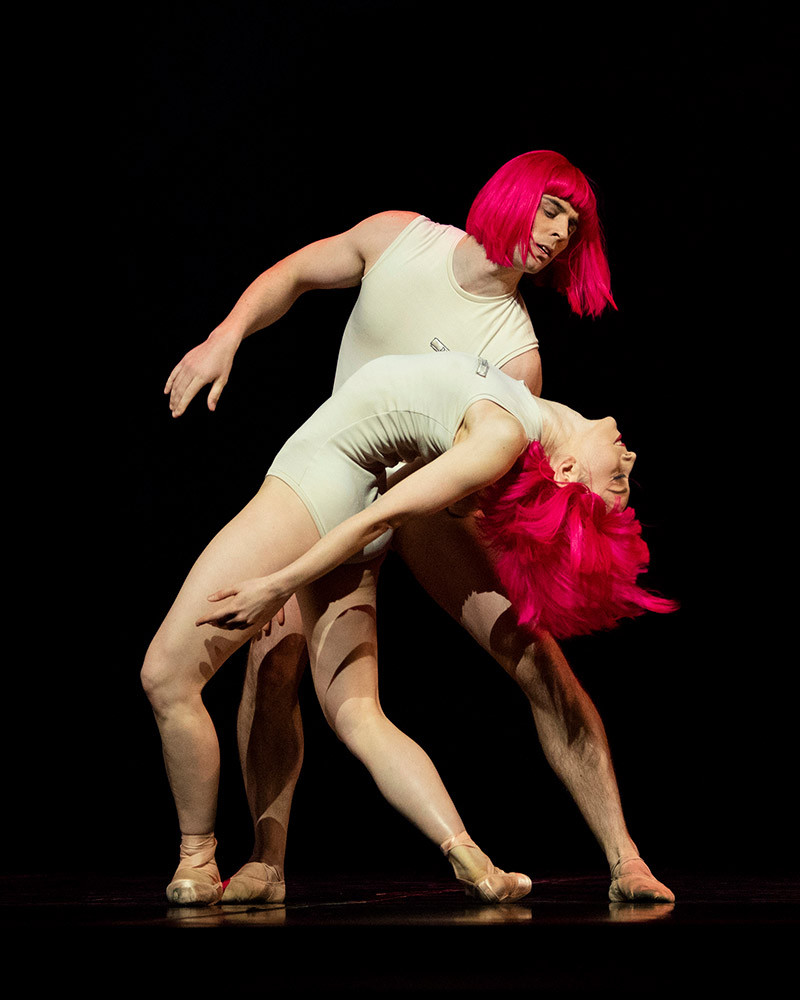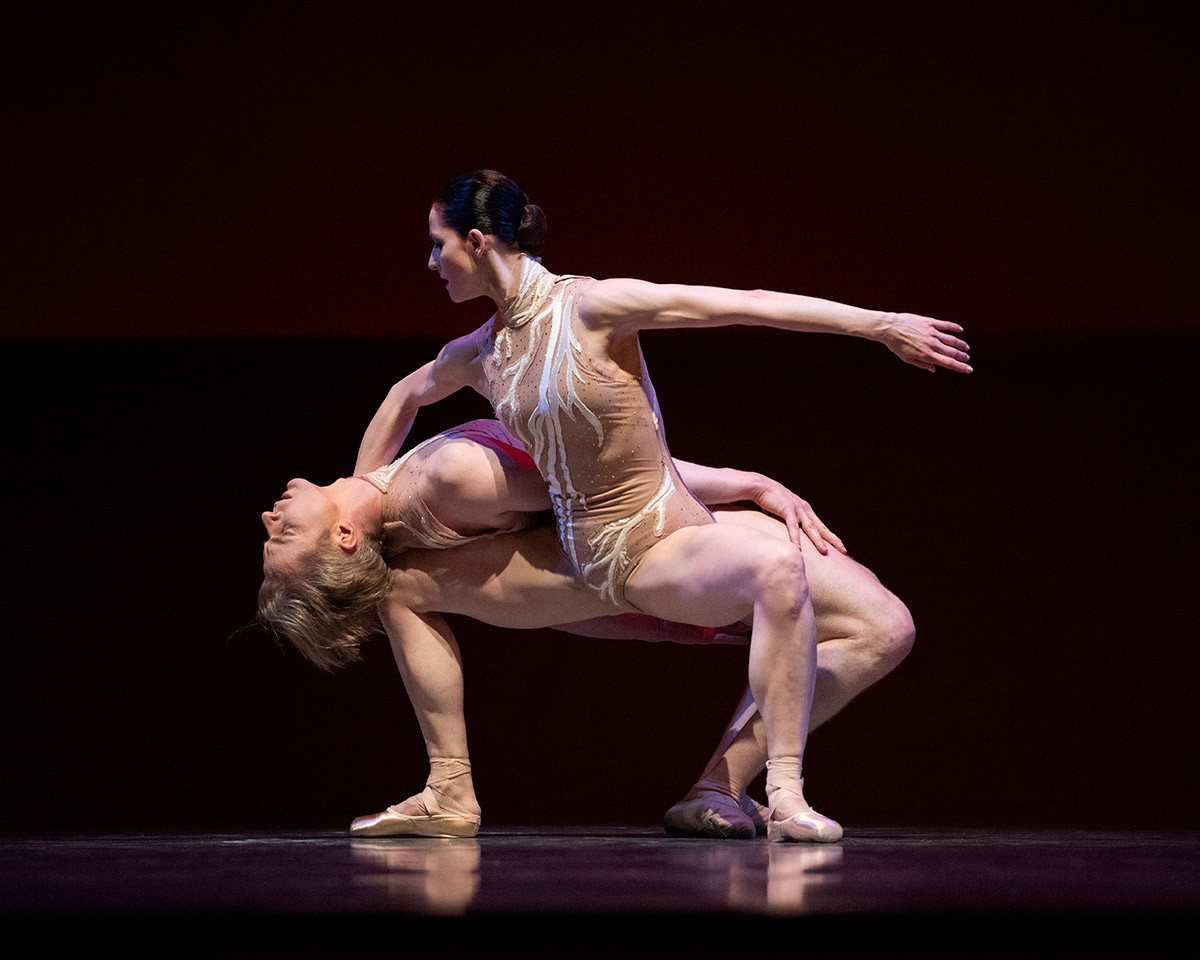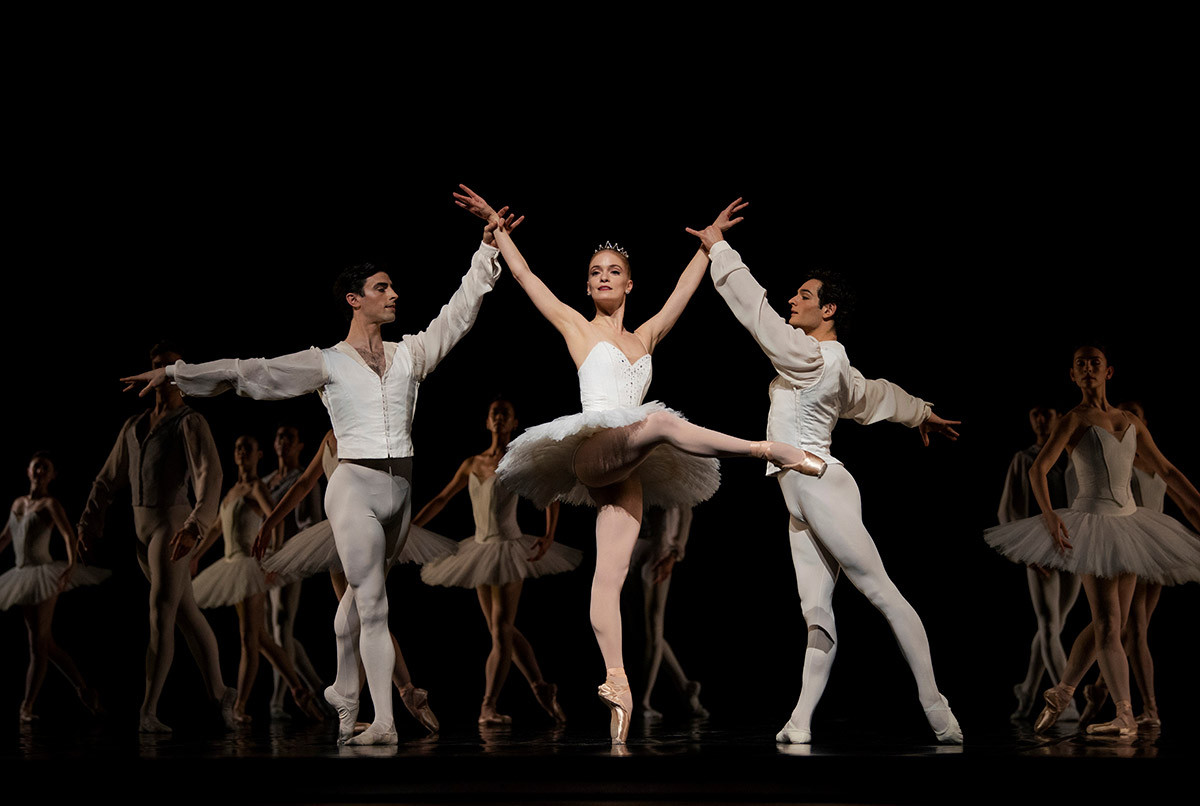San Francisco Ballet’s Program 3, aptly named Dance Innovations, delivered a captivating final performance showcasing a diverse repertory. This program, a mix of revivals and premieres, featured Edwaard Liang’s The Infinite Ocean, a piece originally created for the 2018 Unbound Festival, Harald Lander’s classic ballet tribute Etudes, and the highly anticipated premiere of Trey McIntyre’s The Big Hunger. While both Liang’s and Lander’s pieces offered distinct pleasures, McIntyre’s new work sparked the most conversation, eliciting strong and varied reactions from audiences. Having witnessed The Big Hunger, my own response lands somewhere in the middle, a blend of admiration and reservation.
 San Francisco Ballet in McIntyre
San Francisco Ballet in McIntyre
San Francisco Ballet dancers perform Trey McIntyre’s “The Big Hunger,” a highlight of the Dance Innovations program. © Erik Tomasson.
Trey McIntyre’s The Big Hunger: A Dystopian Dive into Intrigue
The Big Hunger immediately establishes a compelling conceptual world. From the moment the curtain rises, a sense of dystopian mystery pervades the stage. While the narrative remained elusive, the palpable sense of searching and intrigue was undeniable. A fourteen-member cast, clad in striking hot pink wigs, moved with purpose and intensity. Their focused stares and deliberate movements suggested an unfolding drama. Thomas Mika’s set and costume design further amplified this atmosphere, incorporating neon green signage, graffiti elements, and a large chalk outline of a running figure. These visual cues, combined with stage fog and strobe lighting, created a fragmented, almost cinematic experience. Adding to the piece’s dramatic impact was Prokofiev’s score, powerfully conducted by Martin West and featuring pianist Yekwon Sunwoo. The music’s dramatic dissonances, heavy bass, and frenzied passages perfectly mirrored the on-stage tension and ominous undertones. Ordinarily, such overt theatrical devices might feel distracting, but in The Big Hunger, they coalesced into an undeniably intoxicating and cohesive whole.
 Jennifer Stahl and Luke Ingham in McIntyre
Jennifer Stahl and Luke Ingham in McIntyre
Jennifer Stahl and Luke Ingham in a dynamic pose from Trey McIntyre’s “The Big Hunger,” part of San Francisco Ballet’s exploration of dance innovations. © Erik Tomasson.
However, the choreography of The Big Hunger, while initially engaging, left me wanting more in terms of variation. McIntyre presented a vocabulary rich with robotic, mechanized movements, sharp flexions contrasting with classical ballet lines, and frenetic pedestrian-inspired sequences. While these elements were visually interesting, the overall dynamic and choreographic range felt somewhat limited throughout the thirty-minute duration. Whether in duet or ensemble sections, the movement quality and intensity remained largely consistent, which, for me, diminished the overall impact over time.
Edwaard Liang’s The Infinite Ocean: Exploring the Liminal Space with Choreographic Depth
In stark contrast, Edwaard Liang’s The Infinite Ocean proved to be the program’s highlight. Arriving just in time after a train delay, I was immediately drawn into Liang’s emotionally resonant and choreographically intricate work. As the program notes indicated, The Infinite Ocean delves into “the space between life and death.” Liang masterfully explores this theme through nuanced ensemble work for twelve dancers, each performance imbued with individual reactions and intentions. The dancers embodied the journey through this liminal state with unique expressiveness, reminding the audience of the deeply personal nature of such transitions. The staging, framed by a large, luminous orange sun, opened with dancers cautiously surveying their surroundings. Their movement towards the light, followed by hesitant glances back, beautifully conveyed a sense of shared journey undertaken at individual paces. Quiet, introspective moments blossomed into lush, inventive phrases, further emphasizing individual expression through contrasting rhythms. Liang subtly incorporated classical ballet vocabulary, yet often twisted it into striking postures, including a memorable deep second position plié on pointe where women hinge forward, arms extended like delicate wings – a signature motif reminiscent of his earlier work, Wunderland.
 Sofiane Sylve and Tiit Helimets in Liang
Sofiane Sylve and Tiit Helimets in Liang
Sofiane Sylve and Tiit Helimets perform a captivating duet in Edwaard Liang’s “The Infinite Ocean,” part of the Dance Innovations program by San Francisco Ballet. © Erik Tomasson.
The central duet, performed by Sofiane Sylve and Tiit Helimets, was particularly spellbinding. The choreography possessed an almost acrobatic fluidity, evoking the image of figures gliding effortlessly on ice under a bright sun – tranquil yet intensely focused. Subsequent groupings added layers of emotional complexity. Elizabeth Powell and Max Cauthorn brought a wistful quality, while Wona Park and Steven Morse conveyed defiance and resolve. A dynamic pas de trois featuring Julia Rowe, Sean Bennett, and Myles Thatcher pulsed with vibrant energy, though some partnering transitions felt slightly awkward. The ballet culminated with the ensemble moving towards the horizon, each dancer choosing their own pace – some hurried, some lingered, some ran. As Wona Park, the last to depart, leaped into the unknown, a powerful sense of exhilaration and vulnerability filled the space.
Harald Lander’s Etudes: A Reverent Exploration of Ballet Tradition
Harald Lander’s Etudes offered a contrasting experience, a celebration of pure ballet technique and form. This piece, which systematically explores the progression of a ballet class, is always a welcome addition to any program. Knudåge Riisager’s score, inspired by the pedagogical piano works of Carl Czerny, perfectly complements the dance’s focus on mastery and training. Etudes traces the structure of a traditional ballet class – barre work, center work, port de bras, partnering, petit allegro, batterie, and grand allegro – creating an atmosphere of reverence and dedication. Watching Etudes feels akin to witnessing a sacred ritual, a daily practice deeply ingrained in ballet tradition. I find it both technically impressive and meditatively calming. However, I recognize that its length, clocking in at fifty minutes, can be challenging for some viewers. While filled with exquisite and delicate dancing, the extended Romantic-era ballet section can feel slow-paced. Furthermore, the frequent breaks between sections can disrupt the overall flow. Despite these pacing issues, the final tableau, with forty dancers reaching heavenward in unison, remains a breathtaking and iconic image.
 San Francisco Ballet in Lander
San Francisco Ballet in Lander
San Francisco Ballet corps de ballet in Harald Lander’s “Etudes,” a classic work showcasing ballet technique as part of the Dance Innovations program. © Erik Tomasson.
In conclusion, San Francisco Ballet’s Dance Innovations program presented a stimulating mix of choreographic styles and themes. From the dystopian intrigue of McIntyre’s The Big Hunger to the emotional depth of Liang’s The Infinite Ocean and the technical brilliance of Lander’s Etudes, the program offered a multifaceted exploration of dance. While each piece resonated differently, the collective experience underscored San Francisco Ballet’s commitment to showcasing both contemporary dance innovations and balletic traditions.
